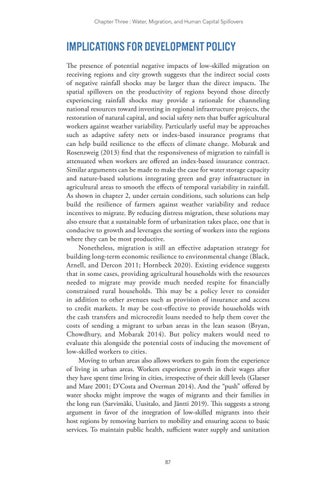Chapter Three : Water, Migration, and Human Capital Spillovers
IMPLICATIONS FOR DEVELOPMENT POLICY The presence of potential negative impacts of low-skilled migration on receiving regions and city growth suggests that the indirect social costs of negative rainfall shocks may be larger than the direct impacts. The spatial spillovers on the productivity of regions beyond those directly experiencing rainfall shocks may provide a rationale for channeling national resources toward investing in regional infrastructure projects, the restoration of natural capital, and social safety nets that buffer agricultural workers against weather variability. Particularly useful may be approaches such as adaptive safety nets or index-based insurance programs that can help build resilience to the effects of climate change. Mobarak and Rosenzweig (2013) find that the responsiveness of migration to rainfall is attenuated when workers are offered an index-based insurance contract. Similar arguments can be made to make the case for water storage capacity and nature-based solutions integrating green and gray infrastructure in agricultural areas to smooth the effects of temporal variability in rainfall. As shown in chapter 2, under certain conditions, such solutions can help build the resilience of farmers against weather variability and reduce incentives to migrate. By reducing distress migration, these solutions may also ensure that a sustainable form of urbanization takes place, one that is conducive to growth and leverages the sorting of workers into the regions where they can be most productive. Nonetheless, migration is still an effective adaptation strategy for building long-term economic resilience to environmental change (Black, Arnell, and Dercon 2011; Hornbeck 2020). Existing evidence suggests that in some cases, providing agricultural households with the resources needed to migrate may provide much needed respite for financially constrained rural households. This may be a policy lever to consider in addition to other avenues such as provision of insurance and access to credit markets. It may be cost-effective to provide households with the cash transfers and microcredit loans needed to help them cover the costs of sending a migrant to urban areas in the lean season (Bryan, Chowdhury, and Mobarak 2014). But policy makers would need to evaluate this alongside the potential costs of inducing the movement of low-skilled workers to cities. Moving to urban areas also allows workers to gain from the experience of living in urban areas. Workers experience growth in their wages after they have spent time living in cities, irrespective of their skill levels (Glaeser and Mare 2001; D’Costa and Overman 2014). And the “push” offered by water shocks might improve the wages of migrants and their families in the long run (Sarvimäki, Uusitalo, and Jäntti 2019). This suggests a strong argument in favor of the integration of low-skilled migrants into their host regions by removing barriers to mobility and ensuring access to basic services. To maintain public health, sufficient water supply and sanitation
87



